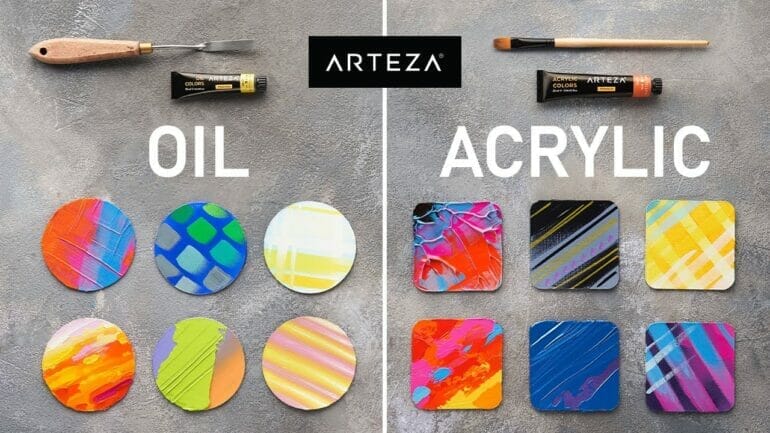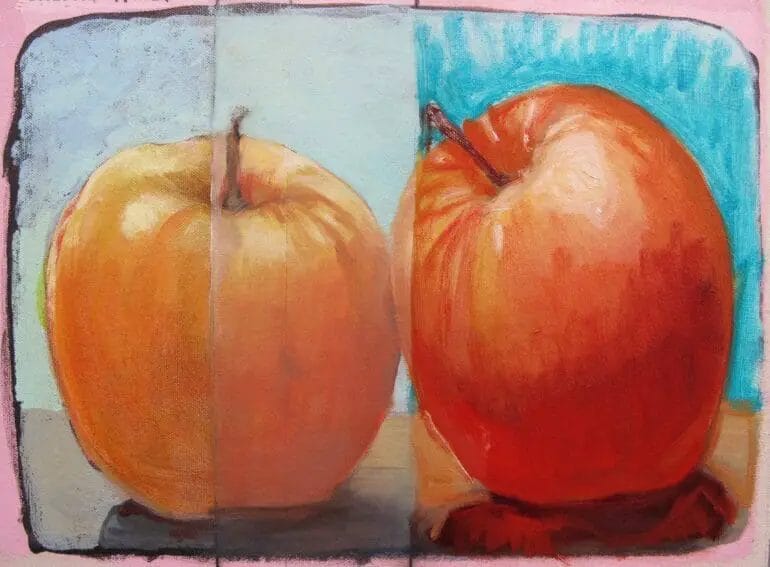If you have a painting and you are unsure whether it is oil or acrylic, there are a few key indicators you can look for to help you determine the medium used.
First, examine the texture of the paint. Oil paintings tend to have a thicker and more layered texture, while acrylic paintings are typically smoother and have a more even surface.
Next, consider the drying time. Oil paints take significantly longer to dry, often taking weeks or even months to fully dry, while acrylic paints dry relatively quickly, usually within hours or a few days.
Another clue is the smell. Oil paints have a distinct odor due to the use of solvents, while acrylic paints are odorless or have a mild, synthetic smell.
You can also look for brushstrokes. Oil paintings often have more visible and textured brushstrokes, while acrylic paintings may have smoother and more uniform brushwork.
Lastly, check for any cracking or yellowing over time. Oil paintings may develop cracks and have a tendency to yellow with age, while acrylic paintings are more resistant to cracking and yellowing.
By considering these factors, you should be able to determine whether a painting is oil or acrylic with more certainty.

Techniques for Determining the Paint Medium
When it comes to painting, one of the crucial decisions an artist must make is choosing the right paint medium. The paint medium refers to the material used to bind the pigments together and create the desired texture and finish. There are several techniques that artists can use to determine the most suitable paint medium for their artwork. Let’s explore some of these techniques in detail.
1. Experimentation
One effective way to determine the paint medium is through experimentation. Artists can try out different mediums on a small scale and observe how they interact with the pigments. By experimenting with various mediums such as oil, acrylic, watercolor, or gouache, artists can gain a better understanding of the unique qualities and characteristics of each medium.
During the experimentation process, artists can explore how the paint medium affects the drying time, transparency or opacity, color intensity, texture, and overall handling of the paint. This hands-on approach allows artists to make informed decisions based on their personal preferences and artistic goals.
2. Research and Study
Another technique for determining the paint medium is through research and study. Artists can delve into books, online resources, or art classes that provide in-depth information about different paint mediums. Understanding the properties and capabilities of each medium can guide artists in making informed choices.
Artists can study the techniques and styles of renowned artists who have worked with specific paint mediums. This research can provide insights into the unique effects that can be achieved with different mediums and inspire artists to explore new possibilities.
3. Consulting with Other Artists
Artists can also benefit from consulting with other experienced artists who have expertise in specific paint mediums. They can join art communities, workshops, or forums where they can interact with fellow artists and seek advice or recommendations.
By discussing their artistic goals and preferences with other artists, beginners can gain valuable insights and guidance. This interaction can help them understand the pros and cons of different paint mediums and narrow down their choices based on the recommendations and experiences shared by others.
4. Consideration of Artistic Intent
One of the most important factors in determining the paint medium is considering the artistic intent. Artists should ask themselves what they want to express through their artwork and what effects they want to achieve.
For example, if an artist aims to create highly textured and layered paintings, oil paints may be the ideal choice due to their slow drying time and ability to blend and build up multiple layers. On the other hand, if an artist prefers quick-drying and vibrant colors, acrylic paints might be more suitable.
By aligning the paint medium with their artistic intent, artists can ensure that their artworks reflect their vision and convey the desired message effectively.
5. Budget and Accessibility
Lastly, artists should also consider their budget and accessibility when determining the paint medium. Some paint mediums may be more expensive or difficult to source compared to others. Artists should evaluate their budget and availability of art supplies to make practical choices.
Additionally, artists should consider the ease of use and cleanup associated with different paint mediums. Some mediums require specific solvents or additional equipment, which may impact the overall cost and convenience.
Summary
Choosing the right paint medium is a crucial decision for artists, as it significantly impacts the outcome of their artwork. By experimenting, conducting research, consulting with other artists, considering their artistic intent, and evaluating budget and accessibility, artists can determine the most suitable paint medium for their creations.
Each technique offers a unique approach to understanding the properties and capabilities of different paint mediums and empowers artists to make informed decisions based on their preferences and artistic goals.

Identifying Characteristics of Oil Paintings
Oil painting is a popular and widely recognized medium in the world of art. Artists have been using oil paints for centuries to create stunning and expressive artworks. The unique characteristics of oil paintings set them apart from other forms of painting, giving them a distinct and timeless appeal. In this section, we will explore the key identifying characteristics of oil paintings.
1. Rich and Vibrant Colors
One of the most notable characteristics of oil paintings is the richness and vibrancy of colors. Oil paints consist of pigments suspended in a drying oil, usually linseed oil. This composition allows artists to achieve deep and intense hues that retain their brilliance over time. The slow drying nature of oil paints also enables artists to blend colors seamlessly, creating smooth transitions and subtle variations in tone.
2. Textural Depth and Brushwork
The texture and brushwork in oil paintings add another layer of visual interest. Unlike other painting mediums, the thicker consistency of oil paints allows artists to apply them in thick impasto or thin glazes, creating a variety of textures. The brushwork in oil paintings can range from bold and expressive strokes to delicate and intricate details. This versatility in brushwork adds texture and dimension to the artwork, giving it a tactile quality.
3. Long Drying Time
Unlike watercolors or acrylics that dry relatively quickly, oil paints have a significantly longer drying time. This characteristic gives artists the advantage of working with the paint for extended periods, allowing them to make adjustments, blend colors, and create intricate details. The slow drying time also enables artists to achieve a wide range of effects and techniques, such as glazing and scumbling.
4. Subtle and Smooth Transitions
Oil paints have a unique ability to create smooth and subtle transitions between colors. Artists can achieve this effect by blending wet paint directly on the canvas or by layering glazes over dry layers. The slow drying time allows artists to manipulate the paint and create seamless transitions, resulting in a realistic and atmospheric quality in the artwork.
5. Durability and Timelessness
Oil paintings are known for their durability and longevity. When properly cared for, oil paintings can last for centuries without significant deterioration. The archival quality of oil paints ensures that the artwork retains its vibrancy and visual appeal over time. This characteristic has made oil paintings a popular choice for collectors, museums, and art enthusiasts who value artworks as long-term investments.
6. Versatility and Layering
Oil paints offer artists a high level of versatility and flexibility. Artists can easily layer colors and build up the composition gradually. This layering technique allows for corrections and adjustments throughout the painting process. Additionally, oil paints can be used on various surfaces, including canvas, wood, and even metal. The versatility of oil paints makes them suitable for a wide range of artistic styles and techniques.
7. Drying and Curing Process
Oil paints undergo a drying and curing process that contributes to their unique characteristics. As the paint dries, it goes through a chemical reaction known as oxidation, which hardens the paint film. This process can take several days or even weeks, depending on the thickness of the paint layers. Once the paint is fully cured, it becomes more stable and less prone to damage or cracking.
Summary
Oil paintings possess distinct identifying characteristics that set them apart from other painting mediums. The rich and vibrant colors, textural depth, long drying time, smooth transitions, durability, versatility, and the drying and curing process all contribute to the unique and timeless appeal of oil paintings. These characteristics make oil paintings a popular choice among artists and art enthusiasts alike.

Signs to Look for in Acrylic Paintings
Acrylic paintings are a popular medium among artists due to their versatility and vibrant colors. Whether you are an art enthusiast or a collector, it is important to know how to identify signs of quality in acrylic paintings. By understanding these signs, you can better appreciate the skill and technique that goes into creating a masterpiece. In this section, we will explore the key indicators that will help you assess the quality of acrylic paintings.
1. Brushwork
One of the first things to look for in an acrylic painting is the brushwork. Skilled artists use different brush techniques to create various textures and effects. Pay attention to the level of detail and precision in the brushstrokes. Are they smooth and controlled or loose and expressive? A well-executed piece will showcase the artist’s ability to manipulate the paint with skill and intention.
2. Color Palette
The choice of colors in an acrylic painting is another important aspect to consider. A skilled artist will carefully select a color palette that complements the subject matter and evokes the desired emotions. Look for harmonious color schemes and consider how the colors interact with each other. The use of bold, vibrant colors can create a sense of energy, while muted tones may convey a more subtle mood.
3. Layers and Depth
Acrylic paint allows artists to build up layers, creating depth and texture in their paintings. Examine the artwork closely to see if there are multiple layers visible. This indicates that the artist has taken the time to build up the composition, adding depth and dimension to the piece. Look for areas where the paint appears translucent or transparent, as this suggests an adept use of layering techniques.
4. Composition and Balance
A well-composed acrylic painting demonstrates a strong sense of balance and harmony. Consider how the elements within the painting are arranged and how they interact with each other. Look for a focal point or points of interest that draw your eye into the artwork. Assess the overall composition to see if it feels visually pleasing and well thought out.
5. Surface Quality
The surface quality of an acrylic painting can also provide valuable insights into its quality. Ideally, the surface should be smooth and free from any visible brushstrokes or texture, unless intentional. Examine the painting from different angles to ensure that there are no uneven patches or areas of inconsistency. A high-quality acrylic painting will have a uniform surface that enhances the overall aesthetic appeal.
6. Signature and Authenticity
Lastly, it is important to look for the artist’s signature and any accompanying certificates of authenticity. These elements confirm the artist’s identity and add value to the artwork. If you are purchasing an acrylic painting, ensure that it is signed by the artist and comes with proper documentation to validate its authenticity.
Summary
Assessing the quality of acrylic paintings requires a keen eye and an understanding of the key indicators of craftsmanship. Pay attention to the brushwork, color palette, layers and depth, composition and balance, surface quality, and the presence of a signature and authenticity. By considering these signs, you can confidently evaluate acrylic paintings and appreciate the skill and artistry behind each piece.
Expert Tips for Distinguishing Oil and Acrylic Paintings
When it comes to art, understanding the medium used can greatly enhance the appreciation and interpretation of a piece. Two popular painting mediums are oil and acrylic, both with their unique characteristics and visual effects. In this section, we will explore expert tips for distinguishing between oil and acrylic paintings.
1. Drying Time
One of the most fundamental differences between oil and acrylic paintings is the drying time. Oil paints have a significantly longer drying time, often taking weeks or even months to fully dry. On the other hand, acrylic paints dry relatively quickly, usually within minutes to hours. By examining the painting’s surface for any signs of dryness, such as cracks or fully dried brush strokes, you can determine whether it is an oil or acrylic painting.
2. Texture and Thickness
The texture and thickness of the paint strokes can also provide clues about the medium used. Oil paints tend to have a thicker and more visible texture due to their slower drying time. The brush strokes may appear more pronounced, creating a sense of depth and dimension. Acrylic paints, on the other hand, have a smoother texture and thinner layers, resulting in a flatter and more uniform surface.
3. Color Vibrancy
Another characteristic to consider when distinguishing between oil and acrylic paintings is the color vibrancy. Oil paints have a natural richness and luminosity that can enhance the depth and intensity of colors. Acrylic paints, although vibrant, may have a slightly different color appearance due to their faster drying time. Additionally, oil paintings tend to have a softer blending of colors, while acrylic paintings may exhibit sharper transitions.
4. Visual Effects
Oil and acrylic paintings can create different visual effects due to their unique properties. Oil paints have a longer open time, allowing artists to blend and manipulate colors more freely. This results in smoother gradients, subtle tonal variations, and realistic skin textures. Acrylic paints, being quick-drying, lend themselves well to creating crisp lines, bold textures, and layered effects. By observing the painting closely, you can identify these distinctive visual effects.
5. Solvent Test
If you are still unsure about the medium used in a painting, you can perform a solvent test. Apply a small amount of solvent, such as rubbing alcohol, to a cotton swab and gently rub it on an inconspicuous area of the painting. If the paint starts to dissolve or become tacky, it is likely an acrylic painting. However, if the paint remains unaffected, it is most likely an oil painting.
Summary
Distinguishing between oil and acrylic paintings can be an intriguing and rewarding process. By considering factors such as drying time, texture, color vibrancy, visual effects, and even performing a solvent test, you can develop a keen eye for differentiating these two painting mediums. Enhancing your understanding of the medium used can greatly enrich your appreciation for art and provide valuable insights into an artist’s creative process.
FAQs
1. How can I tell if a painting is oil or acrylic?
To determine whether a painting is oil or acrylic, you can look for certain visual cues. Oil paint has a richer, more textured appearance with visible brushstrokes and a glossy finish. Acrylic paint tends to have a flatter, smoother appearance with less texture and a matte or satin finish.
2. Are there any other ways to identify if a painting is oil or acrylic?
In addition to visual cues, you can try conducting a solvent test. Dab a cotton swab with a small amount of rubbing alcohol and gently rub it on an inconspicuous area of the painting. If the paint smears or comes off, it is likely acrylic. If it remains unaffected, it is likely oil paint since oil is not soluble in alcohol.
3. Can I seek professional help to determine if a painting is oil or acrylic?
Absolutely! If you are unable to determine the paint type yourself, you can consult an art expert or a professional conservator. They have expertise in analyzing artwork materials and techniques and can help you identify if a painting is oil or acrylic.
Conclusion
In conclusion, determining whether a painting is oil or acrylic can be a challenging task for art enthusiasts. However, by closely examining certain characteristics, one can make an educated guess. Factors such as the drying time, texture, and layering of the paint can provide valuable insights into the medium used. Additionally, consulting an experienced art appraiser or conservator can offer professional assessment and expertise. Remember, understanding the medium of a painting not only adds to its value but also allows for a deeper appreciation of the artist’s technique and skill.
In summary, identifying the difference between oil and acrylic paintings requires a keen eye and a thorough understanding of the characteristics unique to each medium. By paying attention to details such as the paint’s drying time, texture, and layering, one can make an informed judgment. Seeking professional advice from an art expert can provide further clarity. Ultimately, determining the medium of a painting enhances the overall appreciation and value of the artwork.
